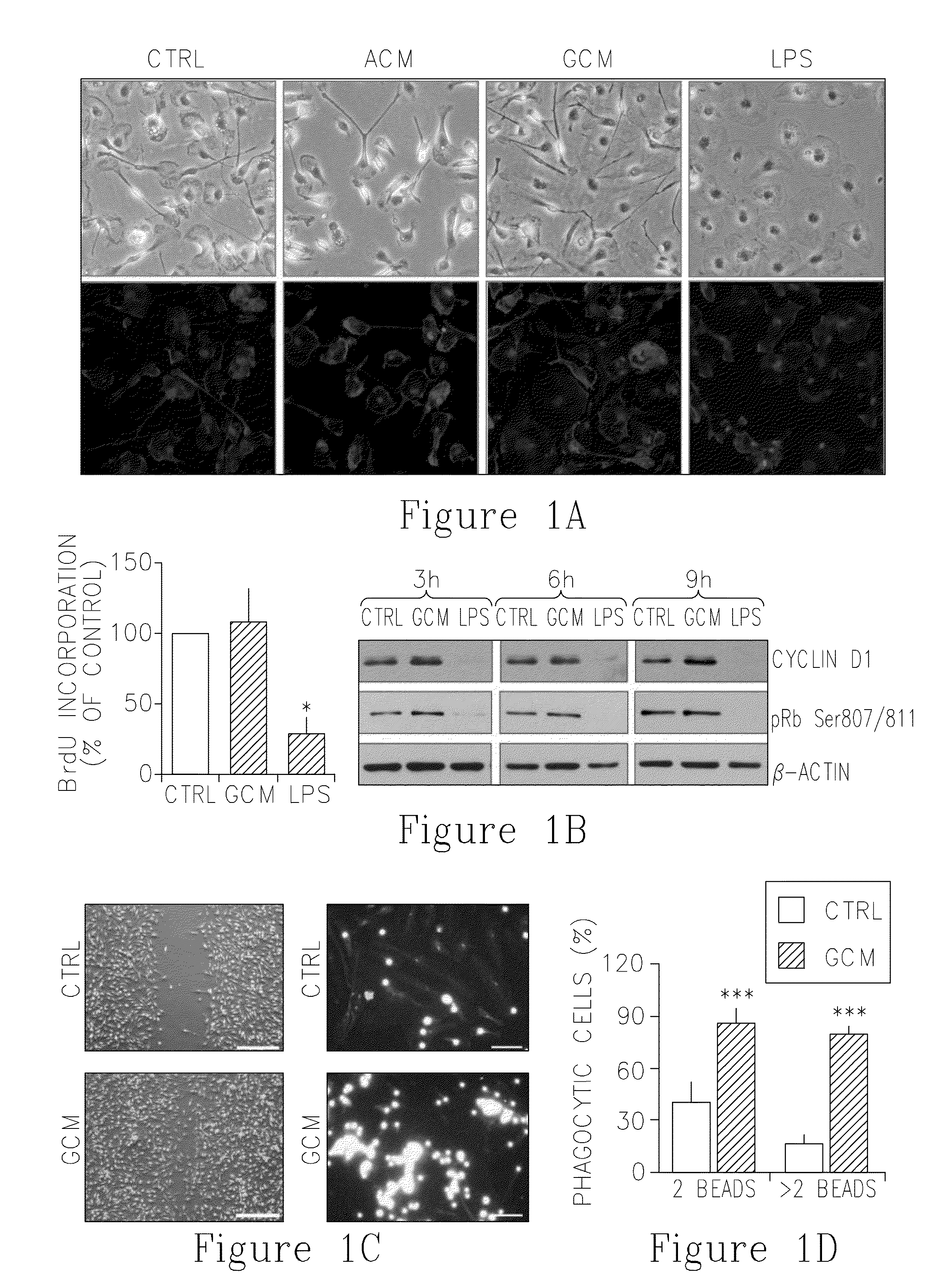Compositions for treating glioma
a technology for glioblastomas and compositions, applied in the field of isolated peptides, can solve the problems of difficult treatment of glioblastomas, and achieve the effects of reducing phagocytosis, reducing motility, and reducing tumor infiltrating
- Summary
- Abstract
- Description
- Claims
- Application Information
AI Technical Summary
Benefits of technology
Problems solved by technology
Method used
Image
Examples
example 1
Materials and Methods
[0242]Cell culture and treatment. Primary cultures of rat microglia were prepared from 1-day-old Wistar rat pups as described previously (Zawadzka and Kaminska 2003). Briefly, cells were isolated from cerebral cortices by trypsination, mechanically dissociated and plated at the density of 3×105 cells / cm2 in Dulbecco's modified Eagle medium (with Glutamax and high-glucose formula 4.5 g / L, Gibco) supplemented with heat-inactivated 10% fetal bovine serum (Gibco), 100 U / mL penicillin, and 0.1 mg / mL streptomycin on poly-L-lysine coated culture 75 cm2 flasks. Murine pEGFP-GL261 glioma cells were cultured in DMEM with 10% FBS and antibiotics (50 U / ml penicillin, 50 μg / ml streptomycin). Primary cultures of astrocytes were prepared from cerebral cortex of 2-day-old C57BL / 6 newborn mice. Astrocytes were cultured in DMEM media with high glucose supplemented with 10% FBS, 100 U / ml penicillin and 100 μg / ml streptomycin. Culture medium was changed after 3 days and then twice ...
example 2
Characterization of Microglia Behaviour and Intracellular Signalling Induced by Glioma-Derived Factors
[0304]Primary microglia cultures isolated from postnatal rat brains were used for all experiments. Purity of microglia cultures was always >95% as determined by FITC-lectin B4 staining. Cultures were left for 48 hours before each experiment to silence microglia. Microglia cultures were exposed to glioma- or astrocyte-conditioned medium, in the absence of other exogenous stimuli or stimulated with 100 ng / mL lipopolysacharide (LPS) which reflects classical inflammatory activation. Only medium from glioma cells (GCM), but not astrocytic cultures, was able to induce morphological transformation of microglia cells into amoeboid cells (FIG. 1A), as evidenced by light contrast microscopy (upper panel) and staining of F-actin with FITC-phalloidin (lower panel). Photographs of cultures were taken 24 hours after addition of the stimulus. Similar morphological transformation was observed after...
example 3
Analysis of Transcriptional Changes Induced by GCM
[0307]As shown in FIG. 3, GCM induces distinct changes in the expression profile of microglia cells.
[0308]To obtain a comprehensive view of genomic responses in GCM stimulated microglia cultures, global gene expression profiling and Gene Ontology analysis was performed in differentially stimulated microglia cells. Global gene expression was probed with Affymetrix oligonucleotide microarrays 6 h after treatments with either GCM or LPS. Separate statistical analysis (t-test) were carried out for the comparison between the GCM (n=4) and the control (MGCM, n=6), and between the LPS (n=4) and the same control. A uniform alpha level of t-test p<0.001 was chosen to identify genes affected by either treatment. This choice corresponds to FDR<0.002 for the more robust changes induced by LPS, and FDR<0.04 for the relatively smaller changes induced by GCM. Changes in expression of genes regulated by GCM (G) and / or LPS (L), as compared to control...
PUM
| Property | Measurement | Unit |
|---|---|---|
| density | aaaaa | aaaaa |
| pore size | aaaaa | aaaaa |
| pH | aaaaa | aaaaa |
Abstract
Description
Claims
Application Information
 Login to View More
Login to View More - R&D
- Intellectual Property
- Life Sciences
- Materials
- Tech Scout
- Unparalleled Data Quality
- Higher Quality Content
- 60% Fewer Hallucinations
Browse by: Latest US Patents, China's latest patents, Technical Efficacy Thesaurus, Application Domain, Technology Topic, Popular Technical Reports.
© 2025 PatSnap. All rights reserved.Legal|Privacy policy|Modern Slavery Act Transparency Statement|Sitemap|About US| Contact US: help@patsnap.com



